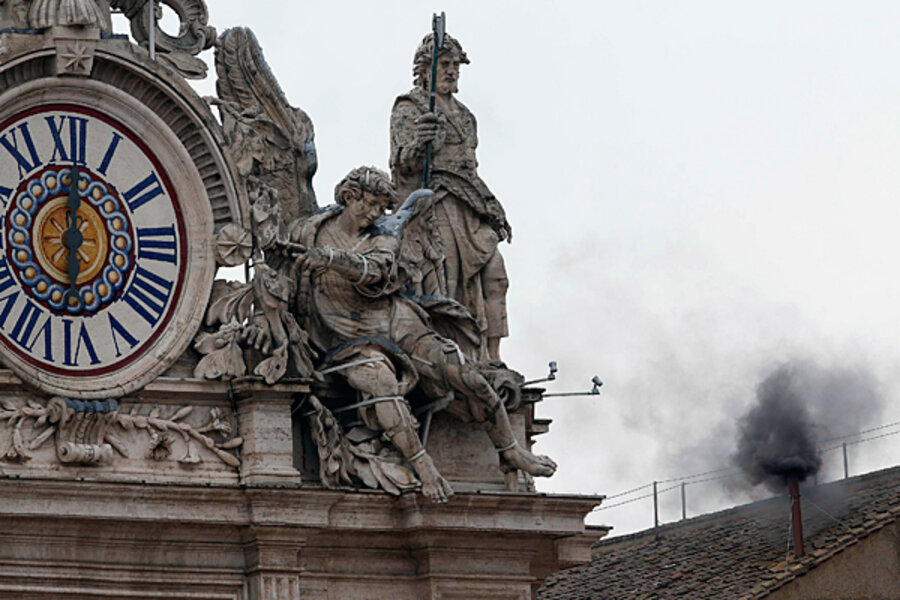Habemus Papam? No. In the meantime, more papal speculation
A third puff of black smoke emerged from a Sistine Chapel stack today where 115 cardinals are gathered – showing an inconclusive vote for the next leader of the world’s 1.2 billion Roman Catholics.
The red-clad prelates are now in the thick of the selection, having vowed absolute secrecy beneath Michelangelo’s painting of “The Last Judgment,” and they will vote four times a day until a puff of white smoke indicating Habemus Papam, or “We have a pope,” emits from the chapel.
Speculation is surging over the mixture of geography, views, symbolism, and personae of the choice, even as the youngest candidate (from India) entered the chapel, while outside on the plaza in stormy early spring weather, many dissident women and nuns engineered puffs of pink smoke to protest for greater female participation in church matters.
A lot of people are now talking of an American pope. The longer the votes remain unresolved, the more chance of a horse-race involving the cardinals from New York and Boston, Timothy Dolan and Sean O’Malley, some Italian media and American news sources today say.
"[W]ith no obvious front-runner Dolan and O’Malley could emerge as potential compromise candidates, if the voting among cardinals drags on without one of the favorites securing the two-thirds support required,” offers a Page 1 story in the Boston Globe today.
The two men appear to be by nature and style nearly polar opposites, with Mr. Dolan a flamboyant media character, and Mr. O’Malley a more pious and demur Franciscan who wears sandals.
“If the cardinals want, not the energizer bunny, but the energizer bear, then they’d go for Dolan," the Globe quotes Terrence W. Tilley of Fordham University as saying. “He has a good, maybe a great public personae, and the PR of the church needs work.”
The possibility of an American pope has been on many lips since Pope Benedict, the former Joseph Ratzinger, became the first head of the Catholic church to resign in some 600 years.
An American pope has long seemed impossible for both symbolic and theological reasons. But some of those strictures seem less binding today. Nick Squires, writing in the Monitor, explains:
There has [in the past] been concern that having an American pope could give the impression that the Vatican had embraced a pro-Washington bias hindering the Catholic Church’s efforts to engage in tangled international issues such as the Israeli-Palestinian conflict, the spread of militant Islam, and poverty alleviation.
But with the end of the cold war and US hegemony declining, those concerns appear to have diminished, because the buzz in Rome is that at least two American cardinals have a fighting chance of being elected the successor to Benedict XVI this week.
John Allen of the National Catholic Reporter, probably one of the finest popular writers extant on church issues, tracks four thematic choices among the cardinals now assembled: church governance, pastoral, developing nation, and what he calls “evangelical.”
The governance impulse would be a vote to clean up a Vatican riddled with corruption, infighting, and institutional chaos, Mr. Allen says. The pastoral theme is a pope far less orthodox and ideological than Benedict, who would focus on healing rifts as paramount. A developing nation pope would be a nod to the two-thirds of the church members that live outside the west. An “evangelical” choice would be someone with the same ultra-strict ideas as Benedict, but who has an outgoing and somewhat charismatic personal touch that reaches out to the public.





